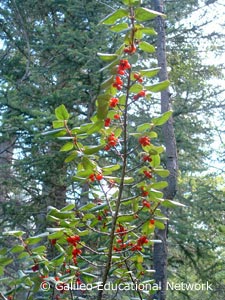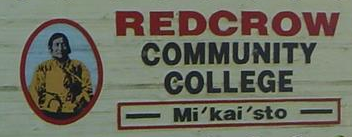Mi’ksiníttsiim – Shepherdia argentea (Pursh) Nutt. (Bull Berry, Thorny Buffalo Berry, Stink Wood)
Learn more about Silver Buffaloberry.
Hear a story told by Marvin Calf Robe Sr.

Marvin Calf Robe Sr.
Mi’ksiníttsiim
Mi’ksiníttsiim iitaottohkooni’p niitahtaistsi kia’siitahtaistsi. Kaniksiistsi iikaiksisakoyaw. Omistsi miinistsi aotahkomaohksinattsiyaw ki iikawakkayssaisskiyaw. Aisttsitsaissiimokos isttohkanaisoka’pi aahkitssiiko’tsiisaa. Iitaita’patapokoyaw ki iitssawattaomayiko niitaossato’pia. Ni’takaiksamaikowan (Pete Standing Alone)annikki i’kamipanaossato’kiaw iikayiko aahkanistoysato’piaw. Iikayahsiiyaw iimakskssiikiaw tsahtao i’kamohtokopskao’kiaw. Iikatayahsiiyaw aistsitsaoyssato’kiaw ahkohtsitsoyo’kiaw. Iikitapsoka’piiyaw akitaistsisookowanio’p ki akitohtssapihsatsoohso’p. Kitommahkitapiiminnooniksi matohtayissitapiyaw mi miini mahkohtaokspanohkio’tsi’sa motokis.
Silver Buffaloberry

Shepherdia argentea (Pursh) Nutt.
Galileo Educational Network
A Silver Buffaloberry Bush can be found near rivers and streams. It has silvery leaves and branches. The leaves are thick and if you look at them closely you will see brown spots. The branches look broken; they grow at odd angles and they have many thorns. The berries are an orangey scarlet colour and grow the whole length of the branch. The bush grows from 2 to 4 metres tall.
The best time to pick the berries is after the first frost. The berries are sweeter then and fall off easily when the bush is hit with a stick. You can collect the berries by using a drop sheet on the ground. Pete Standing Alone told us that if you try and pick them before the frost they do not come off as easily.
The berries can be eaten fresh or dried and are very nutritious. Dried berries taste good in soup. They make a nice garnish for meat, especially buffalo. A berry tea helps stomachaches and works as a mild laxative. The tea helps to clear our mind. Our elders used the berries to make a red dye for hides.
If you burn the wood of the Silver Buffaloberry Bush, beware. It is very stinky and it gives the bush the nick-name of Stink Wood.
Shéperdie argentée

Shepherdia argentea (Pursh) Nutt.
Galileo Educational Network
Les fruits de la shéperdie argentée peuvent être consommés quand ils sont frais ou séchés. Ils sont très nutritifs. Les fruits séchés sont bons dans de la soupe. Aussi, ils servent bien d’accompagnement pour la viande, surtout le bison. Le thé de fruits de shéperdie argentée aide à guérir les maux de ventre. C’est aussi un laxatif pas trop fort. Ce thé nous aide aussi à nous rafraîchir les idées.
Nos aînés faisaient de la teinture rouge avec ces fruits.
Il faut faire attention avant de faire brûler du bois de shéperdie argentée, parce que ça sent très mauvais.

Shepherdia argentea (Pursh) Nutt.
Galileo Educational Network
- Brown, Annora. (1954). Old Man’s Garden. Vancouver, British Columbia: Evergreen Press Limited.
- Glenbow Museum. (2005). Nitsitapiisinni Exhibit Calgary, Alberta: Blackfoot Gallery Committee.
- Hellson, John C. (1974). Ethnobotany of the Blackfoot Indians. Ottawa: National Museums of Canada.
- Johnston, Alex. (1987). Plants and the Blackfoot. Lethbridge, Alberta: Lethbridge Historical Society.
- Kerik, Joan. (1979). Living With The Land: Use of Plants by the Native People Of Alberta. Edmonton, Alberta: Provincial Museum of Alberta.
- Mountain Horse, Mike. (1979). My People The Bloods. Calgary, Alberta: Glenbow Museum.
- Moerman, Daniel E. (1998). Native American Ethnobotany. Portland: Timber Press.





